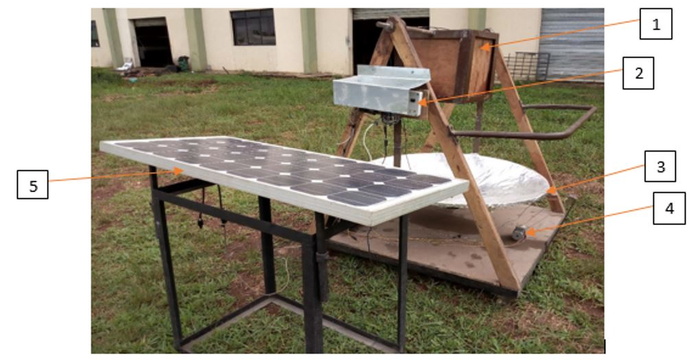According to a new study, a new design for a solar cooking system could help rural communities prepare food more sustainably. The materials used in this system are easily accessible for people in locations where there are limited options apart from burning wood or coal.
 1. Cooking box 2. Data acquisition and solar tracking control unit 3. Parabolic collector/reflector 4. Stepper motor 5. Solar panel connected to the battery. Image Credit: Clement A. Komolafe.
1. Cooking box 2. Data acquisition and solar tracking control unit 3. Parabolic collector/reflector 4. Stepper motor 5. Solar panel connected to the battery. Image Credit: Clement A. Komolafe.
Engineers in Nigeria designed an improved solar cooking system that can replace cooking over fires made with wood, coal or other materials. Many people still cook over such fires in many parts of the world, which is harmful to the environment and also the health of the local community. This new approach combines two traditional solar oven designs to create a healthier and cleaner alternative.
The study was published in the journal Frontiers in Energy Research.
Cooking by the burning of firewood and other non-environmental and non-eco-friendly fuels is still predominant in most developing countries, especially among the people living in rural areas and some urban cities.
Dr. Clement A. Komolafe, Study Lead Author, Landmark University
Dr. Komolafe adds, “In order to discourage the use of hazardous fuels for cooking, we thought of combining the solar box and parabolic dish types to produce one novel solar cooking system using locally sourced materials.”
A Combination of Two Designs
For traditional solar cookers, there are two major arrangements. The first is a box (mostly made of glass or a transparent material) that traps heat from the sun’s rays. The second is a parabolic or spherical structure that reflects and focuses sunlight to increase heat intensity.
To capture even more heat, the latest cooker combines both approaches. Initial tests revealed that the cooker had a maximum heating power (wattage) of 58.2 W, which was sufficient to boil water and cook plantain and rice. This performance is comparable to current solar cooking technology trends.
The latest cooker includes features that make it easy for a single person to operate and assemble. Furthermore, no special training would be required to operate the device.
Locally Sourced Parts and Materials
To construct the device, the researchers used readily available materials like iron, aluminum sheet, plywood, steel pipes and reflective glass. They also compared two easily accessible heat storage materials: black coated gravel (granite) and used engine oil. The electronics required to measure the temperature and humidity for the research were provided by a tracking device.
The next steps include design modifications to further reduce the rate of heat loss through the wall of the cooking box for better efficiency. For quick redistribution of this new device design to rural communities, we’re inviting interested Individuals, corporate organizations, and government parastatals to sponsor or partner in the project.
Dr. Clement A. Komolafe, Study Lead Author, Landmark University
Journal Reference:
Komolafe, C. A. & Okonkwo, C. E. (2022) Design, Fabrication, and Thermal Evaluation of a Solar Cooking System Integrated With Tracking Device and Sensible Heat Storage Materials. Frontiers in Energy Research. doi.org/10.3389/fenrg.2022.821098.
Source: https://www.frontiersin.org/